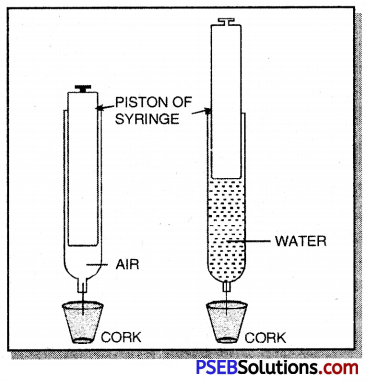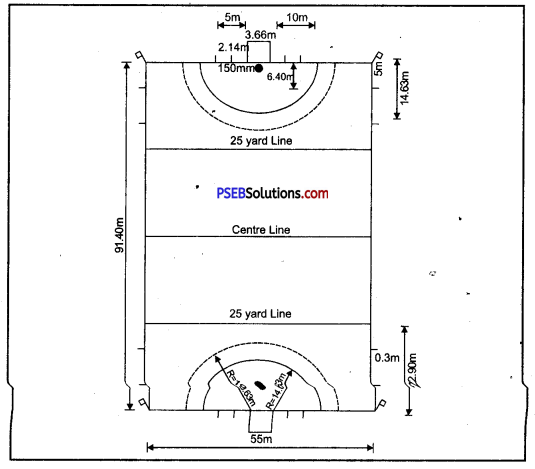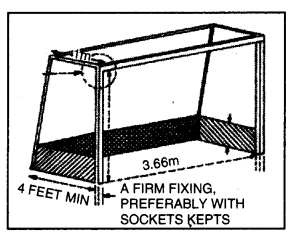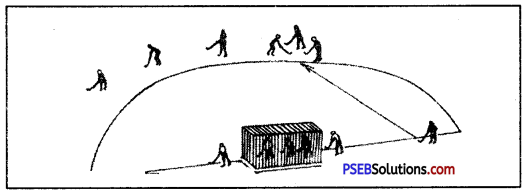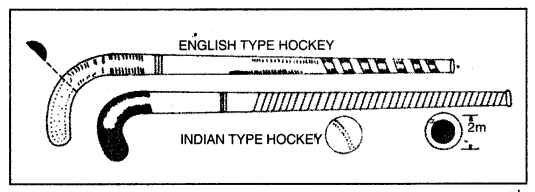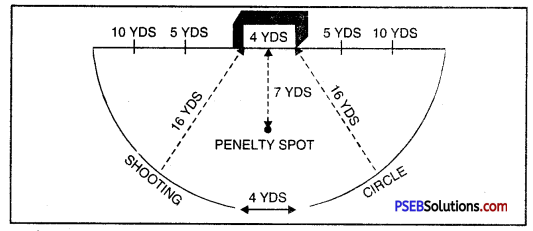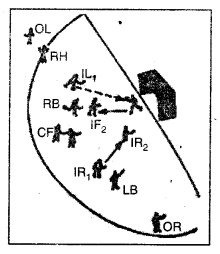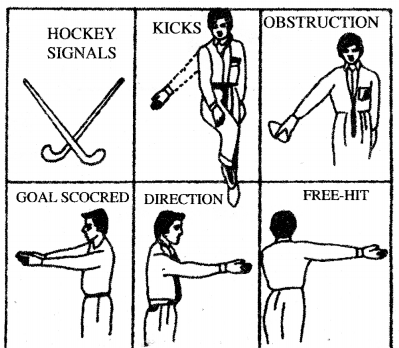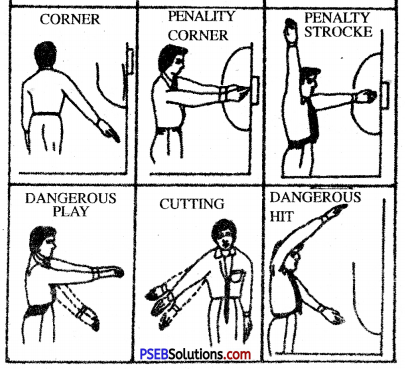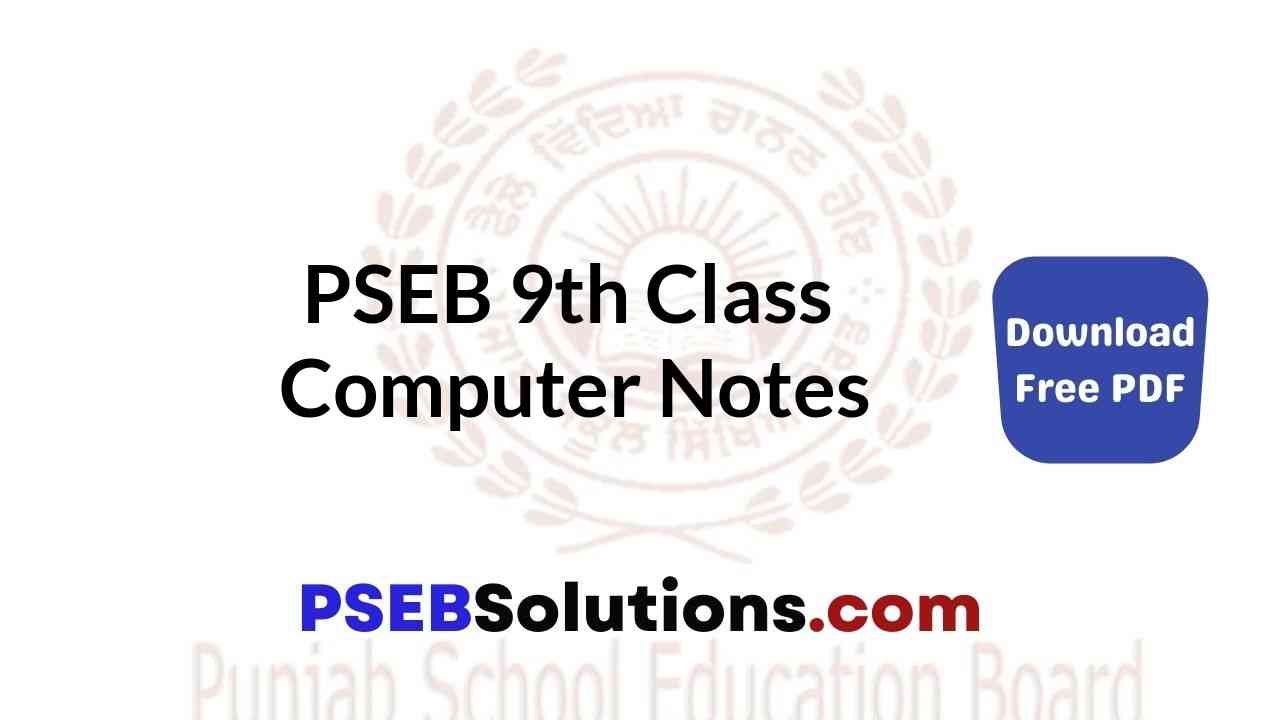Punjab State Board PSEB 10th Class English Book Solutions English Main Course Book Chapter 1 The Happy Prince Textbook Exercise Questions and Answers.
PSEB Solutions for Class 10 English Main Course Book Chapter 1 The Happy Prince
Short Answer Type Questions
Question 1.
Where did the statue of the Happy Prince stand ?
Answer:
It stood on a high column above the city.
यह नगर के ऊपर की तरफ़ एक बहुत ऊँचे स्तम्भ पर खड़ा था।
Question 2.
How was the statue decorated ?
Answer:
The statue was covered with thin leaves of fine gold. It had two bright sapphires for its eyes. There was a large ruby on its sword-hilt.
बुत बढ़िया सोने की बारीक पत्तियों से पूरा ढका हुआ था। उसकी आँखों में दो चमकदार नीलम लगे थे। उसकी तलवार की मूठ पर एक बड़ा लाल माणिक था।
Question 3.
Where was the Swallow going ?
Answer:
The Swallow was going to Egypt. His friends had already gone there.
अबाबील पक्षी मिस्र जा रहा था। उसके मित्र पहले ही वहां जा चुके थे।

Question 4.
Why did the Swallow put up between the feet of the Happy Prince ?
Answer:
It was a fine place between the feet of the Happy Prince. Also, there was plenty of fresh air. That was why the Swallow put up there.
प्रसन्नचित्त राजकुमार के पैरों के मध्य की जगह बहुत बढ़िया थी। साथ में वहां पर्याप्त ताजा हवा भी थी। इसीलिए अबाबील वहां ठहर गया।
Question 5.
Where were the drops coming from ?
Answer:
The drops were coming from the eyes of the statue of the Happy Prince.
बूंदें प्रसन्नचित्त राजकुमार के बुत की आँखों से आ रही थीं।
Question 6.
Why was the Happy Prince crying ?
Answer:
The statue of the Happy Prince had been set up very high. He could see all the sorrows and miseries of the city people. It made him cry.
प्रसन्नचित्त राजकुमार का बुत बहुत ऊँचाई पर स्थापित किया गया था। वह शहर के लोगों के सभी दुःखों और कष्टों को देख सकता था। इससे उसे रोना आ गया।
Question 7.
Describe the seamstress in the words of the Prince.
Answer:
The seamstress had a thin and worn face. She was embroidering flowers on a satin gown. Her hands were coarse and red. They were all pricked by the needle.
दर्जिन का चेहरा दुबला और थका हुआ था। वह साटन के एक गाउन पर फूलों की कढ़ाई कर रही थी। उसके हाथ खुरदरे और लाल थे। वे पूरी तरह से सुई के कारण छिदे हुए थे।
Question 8.
Why was the seamstress’s little boy crying?
Answer:
The little boy was ill. He had fever. He was crying for oranges.
नन्हा लड़का बीमार था। उसे बुखार था। वह संतरों के लिए रो रहा था।
Question 9.
How did the Happy Prince and the Swallow help the seamstress?
Answer:
The Happy Prince asked the Swallow to pluck the ruby out of his sword hilt and take it to the seamstress. The Swallow did the same. Thus they helped the seamstress.
प्रसन्नचित्त राजकुमार ने अबाबील से अपनी तलवार की मूठ से माणिक निकाल कर दर्जिन के पास लेजाने को कहा। अबाबील ने ऐसा ही किया। इस प्रकार उन्होंने दर्जिन की सहायता की।
Question 10.
Why did the Swallow feel warm ?
Answer:
The Swallow had done a good deed. The thought of it made him feel warm.
अबाबील ने एक अच्छा काम किया था। ऐसा सोच कर उसे सुखद गर्मी महसूस हुई।
Question 11.
What troubled the young man in the garret ?
Answer:
The young man in the garret was a poor playwright. He was feeling very cold and there was no fire in the grate. He was feeling hungry also.
अटारी में बैठा युवक एक निर्धन नाटककार था। उसे बहुत ठण्ड लग रही थी और अंगीठी में कोई आग नहीं थी। उसे भूख भी लग रही थी।
Question 12.
How was the young man helped ?
Answer:
The Prince asked the Swallow to pluck out the sapphire from his eye and give it to the young man. The Swallow did as he was told. The young man. became happy on getting the sapphire. He was now able to finish his play.
राजकुमार ने अबाबील को आदेश दिया कि वह उसकी आँख से नीलम निकाल ले और युवक को दे आए। अबाबील ने वैसे ही किया जैसा उसे कहा गया था। नीलम पाकर युवक खुश हो गया। वह अब अपना नाटक समाप्त कर सकता था।

Question 13.
Why was the match girl crying ?
Answer:
The match girl’s matches had fallen into the gutter. They were all spoiled. That was why she was crying.
माचिस बेचने वाली लड़की की माचिसें नाली में गिर गई थीं। वे सब खराब हो गईं थीं। इसी कारण वह रो रही थी।
Question 14.
The Swallow said to the Prince, “I will stay with you always.” Why ?
Answer:
The Prince had given away the sapphires from his eyes for the poor playwright and the match girl. He had now become completely blind. The. Swallow felt deep pity for the Prince and decided to stay with him for ever.
राजकुमार ने अपनी आँखों के नीलम ग़रीब नाटककार और माचिस बेचने वाली लड़की के लिए दे दिए थे। वह अब पूरी तरह अन्धा हो गया था। अबाबील को राजकुमार के लिए गहरी दया महसूस हुई और उसने सदा के लिए उसके साथ रहने का निश्चय कर लिया।
Question 15.
How did the poor Swallow manage to live in so much cold ?
Answer:
The Swallow tried to keep himself warm by flapping his wings. He got some crumbs to eat at the baker’s door. Thus he managed to live in so much cold.
अबाबील अपने पंख फड़फड़ा कर स्वयम् को गर्म रखने की कोशिश करता। उसे नानबाई के दरवाजे पर से कुछ रोटी के टुकड़े खाने को मिल जाते। इस प्रकार उसने इतनी सर्दी में जीने का उपाय
कर लिया।
Question 16.
Why was the statue of the Happy Prince pulled down ?
Answer:
The statue of the Happy Prince had lost all its gold, its ruby and sapphires. :
Now it looked dull and grey. Therefore, it was pulled down.
प्रसन्नचित्त राजकुमार का बुत अपना सब सोना, अपना माणिक और अपने नीलम खो बैठा था। अब वह भूरा और भद्दा दिखाई देता था। इसलिए इसे नीचे गिरा दिया गया।
Question 17.
What were the two most precious things in the city ?
Answer:
The two most precious things in the city were — the dead Swallow and the broken lead heart of the Happy Prince.
शहर में दो सबसे कीमती वस्तुएं थीं – मृत अबाबील और प्रसन्नचित्त राजकुमार का टूटा हुआ सीसे का दिल।
Long Answer Type Questions
Question 1.
Why was the prince called the Happy Prince ?
Answer:
The Prince lived in a palace. No sorrow was allowed to enter there. He never had a taste of sorrow. He did not know what tears were. He always remained happy. Thus he lived, and thus he died. So his courtiers called him the Happy Prince.
राजकुमार एक महल में रहता था। वहां किसी दुःख को प्रवेश करने की इजाजत नहीं थी। उसने कभी किसी दुःख का अनुभव नहीं किया था। वह नहीं जानता था कि आँसू क्या होते हैं। वह सदा प्रसन्न रहता था। वह इसी प्रकार जीवित रहा और ऐसे ही मर गया। इसलिए उसके दरबारी उसे प्रसन्नचित्त राजकुमार कहते थे।
Question 2.
“I cannot choose but weep.” Why did the Happy Prince say so ?
Answer:
The statue of the Happy Prince had been set up very high. He could thus see all the ugliness of the city and the misery of the poor people. But he could not move from his place. His feet were fastened to the pedestal. Therefore, he could not choose but weep.
हैपी प्रिन्स का बुत बहुत ऊंचा लगा हुआ था। इस प्रकार वह शहर की सारी कुरूपता और ग़रीब लोगों के कष्टों को देख सकता था। परन्तु वह अपने स्थान से हिल नहीं सकता था। उसके पैर चौकी से जकड़े हुए थे। इसलिए, वह रोने के अलावा और कुछ नहीं कर सकता था।
Question 3.
Comment on the remark — “The living beings always think that gold can make them happy.’
Answer:
Living beings are greedy by nature. They are never satisfied. The more they have, the more they want. They think that happiness comes with more and more gold and money. But this is not true. Real happiness lies in sympathy and contentment. A sympathetic and contented heart enjoys heavenly joy.
जीवित प्राणी स्वभाव से लालची होते हैं। वे कभी सन्तुष्ट नहीं होते। उनके पास जितना अधिक होता है, वे उतना ही ज्यादा चाहते हैं। वे समझते हैं कि प्रसन्नता अधिकाधिक सोने और पैसे से प्राप्त होती है। किन्तु यह सत्य नहीं है। वास्तविक प्रसन्नता सन्तोष और सहानुभूति में निहित होती है। एक सहानुभूतिपूर्ण और सन्तुष्ट हृदय दैवी प्रसन्नता का आनन्द उठाता है।

Question 4.
Why did the Mayor dislike the statue so much ?
Answer:
The statue of the Happy Prince had lost all its gold, ruby and sapphires. Now it looked dull and grey. It looked no better than a beggar. That was why the Mayor disliked the statue so much. He gave orders to pull it down and melt it in a furnace.
प्रसन्नचित्त राजकुमार का बुत अपना सब सोना, माणिक और नीलम खो बैठा था। अब यह भूरा और भद्दा दिखाई देता था। यह एक भिखारी से कोई बेहतर नहीं लगता था। इसी कारण से मेयर को बुत से इतनी घृणा थी। उसने इसे नीचे गिराने और भट्ठी में पिघलाने का आदेश दे दिया।
Question 5.
Write a short note on the sufferings of the poor people in the city.
Answer:
The poor people in the city lived a miserable life. There was a poor seamstress. She had nothing to give her son who was sick. There was a student who had no firewood to keep himself warm. There was a match girl who had no shoes or stockings. There were hungry and homeless children. There was ugliness and misery everywhere.
नगर में निर्धन लोग एक दयनीय जीवन व्यतीत कर रहे थे। वहां एक निर्धन दर्जिन थी। उसके पास अपने बीमार पुत्र को देने के लिए कुछ नहीं था। वहां एक विद्यार्थी था जिसके पास अपने को गर्म रखने के लिए कोई ईंधन नहीं था। वहां एक माचिस बेचने वाली लड़की थी जिसके पास कोई जूते अथवा जुराबें नहीं थीं। वहां भूखे और बेघर बच्चे थे। वहां हर जगह गन्दगी और दरिद्रता थी।
Question 6.
What is the message conveyed by the author ?
Answer:
The author brings out the secret of true happiness. True happiness comes from serving the poor and the needy. God also blesses such persons. It is clear from the examples of the Happy Prince and the Swallow. The Happy Prince gives his all for the sake of the poor. The poor Swallow sacrifices his life for the sake of the Happy Prince. God blesses both of them. He gives them place in His Paradise.
लेखक सच्ची प्रसन्नता के रहस्य को व्यक्त करता है। सच्ची प्रसन्नता गरीबों और जरूरतमन्दों की सेवा करने से प्राप्त होती है। ईश्वर भी ऐसे लोगों को अपना आशीर्वाद देता है। यह बात प्रसन्नचित्त राजकुमार और अबाबील के उदाहरणों से स्पष्ट हो जाती है। प्रसन्नचित्त राजकुमार अपना सर्वस्व निर्धनों के लिए दे देता है। बेचारा अबाबील हैपी प्रिन्स के लिए अपना जीवन बलिदान कर देता है। ईश्वर उन दोनों को आशीर्वाद देता है। वह उन्हें अपने स्वर्ग में स्थान प्रदान कर देता है।
Vocabulary and Grammar
Question 1.
Fill in the blanks with words that mean both A and B.
Answer:
(b) bank
(c) sound
(d) draw
(e) swallow
(f) close
(g) grate
(h) court.
Question 2.
Fill in the blanks choosing the correct word from the following sets :
Answer:
(a) You have quite drenched me. The patient is sleeping, please keep quiet.
(b) The poet’s heart was filled with joy. Do not hunt the heart. You can be punished for it.
(c) Winter dryness makes her skin coarse. You need good marks to get into this university course.
(d) There is no fire in the grate. She takes great care of her kids.
(e) Do not wander in the rain. The Pyramids are a great wonder.
(f) They pulled down the statue of the Happy Prince. Penalties are laid down in the statute.
(g) Human nature is the same everywhere. All nations believe in the humane treatment of the prisoners of war.
(h) They held their council meeting on Tuesday. I will bear your counsel in mind.
(i) A bird in hand is better than two in the bush. Batter the mixture into a thick paste.
(j) He wrote an official letter. His officious manner made him many enemies.
Question 3.
Match the following words with their antonyms :
Answer:
1. above — below
2. plenty — scarcity
3. bright — dull
4. sorrow — happiness
5. entrance — exit
6. personal — public
7. coarse — smooth
8. delicious — insipid
9. strange — familiar
10. shabby – neat
11. friendly – hostile
12. arrival – departure
13. disease — health
14. angel — devil
15. accept — reject
16. agree — disagree
17. misery — joy
18. appear — vanish
19. create — destroy.

Question 4.
Fill in the blanks using of and off :
Answer:
1. Send me a cup of tea.
2. I washed the dirt off my hands.
3. Get off the bus at the next stop.
4. Send me a copy of this story.
5. Did you get a day off this week ?
6. She died of heart failure.
7. It was nice of you to send me flowers.
8. He fell off the bed and broke his leg.
9. He is a member of the Parliament.
10. She is better off without him.
Question 5.
Rewrite the following sentences in their past perfect and past perfect continuous form :
Answer:
1. (a) The town had made all preparations.
(b) The town had been making all preparations.
2. (a) He had passed by the cathedral tower.
(b) He had been passing by the cathedral tower.
3. (a) You had done a good action.
(b) You had been doing a good action.
4. (a) I had come to bid you goodbye.
(b) I had been coming to bid you goodbye.
5. (a) He had slept at the Prince’s feet.
(b) He had been sleeping at the Prince’s feet.
6. (a) The Swallow had flown over the great city.
(b) The Swallow had been flying over the great city.
7. (a) They had pulled down the statue of the Happy Prince.
(b) They had been pulling down the statue of the Happy Prince.
8. (a) He had picked up crumbs outside the baker’s door.
(b) He had been picking up crumbs outside the baker’s door.
9. (a) They had melted the statue in a furnace.
(b) They had been melting the statue in a furnace.
10. (a) The poor little Swallow had grown colder and colder.
(b) The poor little Swallow had been growing colder and colder.
Question 6.
Punctuate the following paragraph :
Answer:
Jack shouted back at his accuser, “You want to massacre 150,000 people for nothing !” Spitting out his words with fury, Roger, the senior officer, in the room shouted, “I have never seen such a gutsless general like you, Jack !”
Question 7.
Make adjectives and use them in sentences :
Answer:
1. Brilliant – He is a brilliant student.
2. Quick – She was quick to point out all the mistakes I’d made.
3. Nervous – Interviews always make me nervous.
4. Bright – Tomorrow’s weather will be cloudy with bright periods.
5. Eager – I as eager to know my exam result.
6. Careful – Be careful while crossing the road.
7. Critical – The patient’s condition is critical.
8. Simple – This machine is quite simple to use.
9. Sudden – Their departure was very sudden.
10. Loving – She is my loving daughter.
Objective Type Questions
Question 1.
The drops were coming from the …………….. of the Happy Prince.
Answer:
1. eyes
Question 2.
The son of the seamstress was crying because he wanted to go to Egypt. (True, False)
Answer:
False
Question 3.
The poor seamstress was given the …………….. by the swallow.
(i) gold
(ii) sapphire
(iii) ruby
(iv) oranges.
Answer:
(iii) ruby
Question 4.
Who ordered to pull down the statue of the Happy Prince ?
(i) Mayor
(ii) Swallow
(iii) Seamstress
(iv) Playwright.
Answer:
(i) Mayor
Question 5.
The statue of the Happy Prince was decorated with diamonds. (True/False)
Answer:
False
Question 6.
Who was sent to bring the two most precious things from the city ?
(i) Mayor
(ii) God
(iii) Angel
(iv) Match-girl.
Answer:
(iii) Angel
Question 7.
The man in the garret was writing a …
Answer:
play.
Answer each of the following in one word / phrase / sentence :
Question 1.
What type of palace did the Happy Prince live in ?
Answer:
It was a palace where no sorrow was allowed to enter.
Question 2.
Where did the statue of the Happy Prince stand ?
Answer:
It stood on a tall column high above the city.
Question 3.
Where were the friends of the Swallow waiting ?
Answer:
They were waiting for the Swallow in Egypt.
Question 4.
What was the seamstress doing ?
Answer:
She was embroidering flowers on a satin gown.
Question 5.
What did the Swallow take to the seamstress’s house ?
Answer:
She took the ruby from the sword-hilt of the Happy Prince.

Question 6.
What was used for the eyes of the Happy Prince ?
Answer:
Two bright sapphires were used as the eyes of the Happy Prince.
Question 7.
What was the heart of the Happy Prince made of ?
Answer:
It was made of lead.
Question 8.
Who got a sapphire from the Swallow ?
Answer:
The playwright got a sapphire from the Swallow.
Question 9.
Why did the Swallow feel warm even when it was biting cold outside ?
Answer:
Because he had done a good deed.
Question 10.
Why was the match girl weeping ?
Answer:
She was weeping because her matches had fallen into the gutter.
Question 11.
Who brought God the leaden heart and the dead bird ?
Answer:
One of God’s angels brought them to Him.
Question 12.
What were the two most precious things in the city ?
Answer:
They were the leaden heart of the Happy Prince and the dead bird.
Complete the following :
1. There was no fire in the play wright’s …………..
2. The seamstress was embroidering . ……………… on a satin gown.
3. The Swallow plucked out the …………………. from the Prince’s sword.
4. The Swallow decided to put up between the ……………… of the Happy Prince.
5. The statue of the Happy Prince was gilded all over with …………. of fine gold.
6. The Happy Prince did not know what ………………… were when he lived . in the palace.
7. From above, Happy Prince could see the . ……….. of the city.
8. The Mayor said, “He is little better than a ……………….
Answer:
1. grate
2. flowers
3. ruby
4. feet
5. leaves
6. tears
7. misery
8. beggar.
Write True or False against each statement :
1. God gave a place to the Happy Prince in his city of gold.
2. Swallow’s friends were waiting for him in Egypt.
3. The play wright was a very rich man.
4. The Happy Prince lived a miserable life when he was alive.
5. The statue was set up in a park.
6. The heart of the Happy Prince was made of lead.
7. The Town Councillors praised the statue of Happy Prince. –
Answer:
1. True
2. True
3. False
4. False
5. False
6. True
7. False
Choose the correct option for each of the following :
Question 1.
In his palace, the Happy Prince had lived …………..
(a) a happy life
(b) a miserable life
(c) a student life
(d) a sorrowful life.
Answer:
(a) a happy life
Question 2.
The statue of the Happy Prince stood ……
(a) in the palace
(b) inside a park
(c) on a platform
(d) on a tall column.
Answer:
(d) on a tall column.
Question 3.
The seamstress …………. when the Swallow came to her house.
(a) was talking to her son
(b) was playing with her son
(c) was fanning the boy’s head
(d) was asleep.
Answer:
(d) was asleep.
Question 4.
The statue was gilded all over with : ………….
(a) precious jewels
(b) solid gold
(c) thin leaves of gold
(d) artistic paintings.
Answer:
(c) thin leaves of gold

Question 5.
The Swallow’s friends had already gone to …………
(a) West Africa
(b) South Africa
(c) Egypt
(d) none of the above.
Answer:
(c) Egypt
Question 6.
The Swallow took shelter ……………….. of the Prince.
(a) between the feet
(b) on the shoulder
(c) on the hand
(d) on the sword.
Answer:
(a) between the feet
The Happy Prince Summary & Translation in English
The Happy Prince Introduction:
The Happy Prince lived a carefree life as long as he was alive. He lived in the palace of happiness. No sorrow was allowed to enter his palace. His courtiers called him the Happy Prince. So he lived and so he died. After his death, a statue of the Happy Prince was set up on a tall column. The statue was made of lead but was covered with gold. The eyes were made of sapphires and the sword-hilt had a ruby on it. The Happy Prince had a very kind heart. When he saw the misery of the poor people, his heart melted with pity. He gave away his ruby, sapphires and all the gold for the poor. He became blind and his body looked ugly. But he was happy at heart because real happiness comes from serving the poor and the needy. Though his heart was made of lead, yet it broke when his beloved Swallow died. God blessed the Happy Prince and was pleased to have him in His city of gold.
The Happy Prince Summary & Translation in English:
Page -1
High above the city, on a tall column? stood the statue of the Happy Prince. He was gilded all over with thin leaves of fine gold; for eyes, he had two bright sapphires, and a large red ruby glowed on his sword-hilt?
One night, there flew over the city a little Swallow. His friends had gone away to Egypt six weeks before, but he had stayed behind; then he decided to go to Egypt too.
All day long he flew, and at night time he arrived at the city.
“Where shall I put up ?” he said, “I hope the town has made preparations.”
Then he saw the statue on the tall column.
“I will put up there,” he cried. “It is a fine position with plenty of fresh air.” So he alighted just between the feet of the Happy Prince.
“I have a golden bedroom,” he said softly to himself as he looked round, and he prepared to go to sleep; but just as he was putting his head under his wing a large drop of water fell on him. “What a curious thing !” he cried. “There is not a single cloud in the sky; the stars are quite clear and bright, and yet it is raining.” Then another drop fell.
“What is the use of a statue if it cannot keep the rain off ?” he said. “I must look for a good chimney pot,” and he determined to fly away. But before he had opened his wings, a third drop fell, and he looked up, and saw — Ah ! what did he see ?
Page -2
The eyes of the Happy Prince were filled with tears?, and tears were running down his golden cheeks. His face was so beautiful in the moonlight that the little Swallow was filled with pity.
“Who are you ?” he said. “I am the Happy Prince.”
“Why are you weeping then ?” asked the Swallow. “You have quite drenched me.”
“When I was alive and had a human heart,” answered the statue, “I did not know what tears were, for I lived in the palace, where sorrow is not allowed to enter. My courtiers? called me the Happy Prince, and happy indeed I was. So I lived, and so I died. And now that I am dead, they have set me up here so high that I can see the ugliness and all the miseryo of my city, and though my heart is made of lead yet I cannot chooseli but weep.”
“What ! Is he not solid gold ?” said the Swallow to himself. He was too political to make any personal remarks.
“Far away,” continued the statue in a low musical voice, “far away in a little street there is a poor house. One of the windows is open, and through it I can see a woman seated at a table. Her face is thin and worn, and she has coarse, red hands, all pricked by the needle, for she is a seamstress. She is embroidering flowers on a satin gown for the loveliest of the Queen’s maids of honour, to wear at the next Court ball?. In a bed in the corner of the room, her little boy is lying ill. He has fever?, and is asking his mother to give him oranges. His mother has nothing to give him but river water, so he is crying. Swallow, little Swallow, will you not bring her the ruby out of my sword-hilt ? My feet are fastened to this pedestal and I cannot move.”
“I am waited for in Egypt,” said the Swallow. “My friends are flying up and down the Niles, and talking to the lotus flowers. Soon they will go to sleep.”

Page 3
The Prince asked the-Swallow to stay with him for one night and be his messenger?. “The boy is so thirsty, and the mother so sad,” he said.
“I don’t think I like boys,” answered the Swallow. “I want to go to Egypt.”
But the Happy Prince looked so sad that the little Swallow was sorry. “It is very cold here,” he said. But he agreed to stay with him for one night and be his messenger.
“Thank you, little Swallow,” said the Prince.
The Swallow picked out the great ruby from the Prince’s sword, and flew away with it in his beak over the roofs of the town.
He passed by the cathedral10 tower, where the white marble angels were sculptured. He passed by the palace and heard the sound of dancing. A beautiful girl came out on the balcony with her lover.
“I hope my dress will be ready in time for the State ball,” she answered. “I have ordered flowers to be embroidered on it, but the seamstresses are so lazy.” He passed over the river, and saw the lanterns hanging on the masts of the ships. At last he came to the poor house and looked in. The boy was tossing feverishly on his bed, and the mother had fallen asleep; she was so tired. In he hopped, and laid the great ruby on the table beside the woman’s thimble. Then he flew gently round the bed, fanning the boy’s forehead with his wings. “How . cool I feel !“ said the boy, “I must be getting better,” and he sank into a delicious slumber.
Then the Swallow flew back to the Happy Prince, and told him what he had done. “It is curious,” he remarked, “but I feel quite warm now, although it is so cold.”
Page – 4
“That is because you have done a good action,” said the Prince. And the little Swallow began to think and then fell asleep. Thinking always made him sleepy. When the moon rose, he flew back to the Happy Prince. “Have you any commissions for Egypt ?“ he cried. “I am just starting.”
“Swallow, Swallow, little Swallow,”said the Prince, “Will you stay with me one night longer ?“ “I am waited for in Egypt,” answered the Swallow.
“Swallow, Swallow, little Swallow,” said the Prince, “far away across the city I see a young man in a garret?. He is leaning over a desk covered with papers, and in the glass by his side there is a bunch of withered violets. His hair is brown and crisp and his lips are red as pomegranates, and he has large and dreamy eyes. He is trying to finish a play for the Director of the Theatre, but he is too cold to write any more. There is no fire in the grate”, and hunger has made him faint.”
“I will wait with you one night longer,” said the Swallow, who really had a good heart. He asked if he should take another ruby to the young play wrigh to. “Alas ! I have no ruby10 now,” said the Prince. “My eyes are all that I have left. They are made of rarell sapphires, which were brought out of India a thousand years ago.” He ordered the Swallow to pluck out one of them and take it to the playwright. “He will sell it to the jeweller, and buy firewood , and finish his play,” he said.
“Dear Prince,” said the Swallow, “I cannot do that,” and he began to weep.
“Swallow, Swallow, little Swallow,” said the Prince, “do as I command you.”
Page 5
So the Swallow plucked out the Prince’s eye, and flew away to the student’s garret. It was easy enough to get in, as there was a hole in the roof. Through this he darted, and came into the room. The young man had his head buried in his hands, so he did not hear the flutter of the bird’s wings, and when he looked up he found the beautiful sapphire lying on the withered violets.
“I am beginning to be appreciated?,” he cried. “This is from some great admirer. Now I can finish my play,” and he looked quite happy.
The next day, the Swallow flew down to the harbour. He sat on the mast of a large vessel and watched the sailors working. “I am going to Egypt,” cried the Swallow, but nobody minded, and when the moon rose he flew back to the Happy Prince.
“I have come to bid you goodbye,” he cried.
“Swallow, Swallow, little Swallow,” said the Prince, “will you not stay with me one night longer ?”
“It is winter,” answered the Swallow, “and the snow will soon be here. In Egypt, the sun is warm on the green palm trees?, and the crocodiles8 lie in the mud and look lazily about them.”
“In the square below,” said the Happy Prince, “there stands a little match girl. She has let her matches fall in the gutterlo, and they are all spoiled. Her father will beat her if she does not bring home some money, and she is crying. She has no shoes or stocking, and her little head is barell. Pluck out my other eye, and give it to her, and her father will not beat her.” “I will stay with you one night longer,” said the Swallow, “but I cannot pluck out your eye. You would be quite blind then.”
“Swallow, Swallow, little Swallow,” said the Prince, “do as I command you.”
So he plucked out the Princess other eye, and darted down with it. He swooped’ past the match girl, and slipped the jewel into the palm of her hand. “What a lovely bit of glass !“ cried the little girl; and she ran home, laughing.
Then the Swallow came back to the Prince. “You are blind now,” he said, “so I will stay with you always”
“No, little Swallow,” said the poor
Prince, “you must go away to Egypt.”
“No, I will stay with you always,” said the Swallow, and he slept at the Prince’s feet.

Page -6
All the next day, he sat on the Prince’s shoulder, and told him stories of what he had seen in strange lands.
“Dear little Swallow,” said the Prince, “you tell me of marvellous things, but more marvellous than anything is the suffering of men and of women. There is no Mystery so great as Misery. Fly over my city, little Swallow, and tell me what you see there.”
So the Swallow flew over the great city, and saw the rich making merry in their beautiful houses, while the beggars were sitting at the gates. He flew into dark lanes, and saw the white faces of starving children looking out listlessly at the black streets. Under the archway of a bridge two little boys were lying in each other’s arms to try to keep themselves warm. “How hungry we are !” they said. “You must not lie here,” shouted the watchman, and they wandered out into the rain.
Then he flew back and told the Prince what he had seen.
“I am covered with fine gold,” said the Prince. “You must take it off, leaf by leaf, and give it to the poor; the living always think that gold can make them happy.” Leaf after leaf of the fine gold, the Swallow picked off, till the Happy Prince looked quite dull1 and grey. Leaf after leaf of the fine gold he brought to the poor and the children’s faces grew rosier, and they laughed and played in the street. “We have bread now !” they cried.
Page – 7
Then the snow came, and after the snow came the frost. The streets looked as if they were made of silver. Everybody went about in furs, and the little boys wore scarlet caps and skated on the ice. The poor little Swallow grew colder and colder, but he would not leave the Prince; he loved him too well. He picked up crumbs outside the baker’s door when the baker was not looking, and tried to keep himself warm by flapping his wings.
But at last he knew that he was going to die. He had just enough strength to fly to the Prince’s shoulder once more. “Goodbye, dear Prince !” he murmured, “will you let me kiss your hand ?”
“I am glad that you are going to Egypt at last, little Swallow,” said the Prince. “You have stayed too long here but you must kiss me on the lips, for I love you.” “It is not to Egypt that I am going,” said the Swallow. “I am going to the House of Death. Death is the brother of Sleep, is he not ?”
And he kissed the Happy Prince on the lips, and fell down dead at his feet.
At the moment, a curious crack sounded inside the statue, as if something had broken. The fact is that the leaden heart had snapped right in two. It certainly was a dreadfully hard frost.
Early the next morning, the Mayor was walking in the sqaure below in company with the Town Councillors . As they passed the column, he looked up at the statue. “Dear me! how shabby the Happy Prince looks !” he said.
Page – 8
“How shabby, indeed !” cried the Town Councillors, who always agreed with the Mayor and they went up to look at it.
“The ruby has fallen out of his sword, his eyes are gone, and he is golden no longer,” said the Mayor. “In fact, he is little better than a beggar !”
“Little better than a beggar,” said the Town Councillors.
“And here is actually a dead bird at his feet!” continued the Mayor. “We must really issue a proclamation that birds are not to be allowed to die here.” And the Town Clerk made a note of the suggestion.
So they pulled down the statue of the Happy Prince. “As he is no longer beautiful he is no longer useful,” said the Art Professor at the University.
Then they melted the statue in a furnace. “What a strange thing !” said the overseer of the workmen at the foundry. “This broken lead heart will not melt in the furnace. We must throw it away.” So they threw it on a dust-heap1 where the dead Swallow was also lying.
“Bring me the two most precious things in the city,” said God to one of His Angels; and the Angel brought Him the leaden heart and the dead bird.
“You have rightly chosen,” said God,
“for in my garden of Paradise, this little bird shall sing for ever more and in my city of gold the Happy Prince shall praise me.”
The Happy Prince Summary & Translation in Hindi
The Happy Prince Introduction:
प्रसन्नचित्त राजकुमार जब तक जीवित था, उसने एक चिन्ता-मुक्त जीवन व्यतीत किया। वह खुशी के महल में रहता था। किसी भी प्रकार के दुःख को इस महल में घुसने की आज्ञा नहीं थी। उसके दरबारी उसे प्रसन्नचित्त राजकुमार कहा करते थे। वह इसी तरह खुशी में जिया और खुशी में ही मरा। उसकी मृत्यु के पश्चात् प्रसन्नचित्त राजकुमार का एक बुत एक ऊँचे स्तम्भ पर लगा दिया गया। बुत सीसे (सिक्के) का बना था लेकिन यह पूरा सोने से ढका हुआ था।
उसकी आंखें नीलम की बनी थीं और उसकी तलवार के मुठे पर एक माणिक लगा था। प्रसन्नचित्त राजकुमार का हृदय बहुत दयालु था। जब उसने ग़रीब लोगों का दुःख देखा तो उसका दिल दया से पिघल गया। उसने अपना माणिक, नीलम और सारा सोना गरीबों के लिए त्याग दिया। वह अन्धा हो गया और उसका शरीर भद्दा दिखाई देने लगा।
लेकिन उसका मन प्रसन्न था क्योंकि वास्तविक प्रसन्नता ग़रीबों तथा जरूरतमंदों की सहायता करने से मिलती है। यद्यपि उसका दिल सीसे का बना था, यह टूट कर दो टुकड़े हो गया जब उसका प्रिय अबाबील पक्षी मर गया। ईश्वर ने प्रसन्नचित्त राजकुमार को अपना आशीर्वाद दिया तथा उसे प्रसन्नतापूर्वक अपने सोने के नगर अर्थात् स्वर्ग में स्थान प्रदान कर दिया।
The Happy Prince Summary & Translation in Hindi:
Page -1
नगर में बहुत ऊँचे स्तम्भ पर प्रसन्नचित्त राजकुमार | का बुत खड़ा था। वह पूरा सोने की बारीक पत्तियों से । ढका था; उसकी आंखों के लिए दो चमकदार नीलम थे, और उसकी तलवार की मूठ पर एक बड़ा लाल माणिक चमक रहा था।
एक रात उस शहर के ऊपर एक छोटा अबाबील | उड़ता हुआ आया। उसके मित्र छ: सप्ताह पूर्व मिस्र चले – गए थे, किन्तु वह पीछे रह गया था; फिर उसने भी मिस्त्र जाने का निश्चय कर लिया।
दिन भर वह उड़ता रहा और रात के समय वह नगर – में आ पहुंचा।
“मैं कहां ठहरूंगा ?” उसने कहा, “मुझे आशा है कि नगर ने (मुझे ठहराने की) तैयारियां कर ली हैं।”
फिर उसने ऊंचे स्तम्भ पर खड़े बुत को देखा।
“मैं वहां ठहरूंगा,” उसने ऊंचे स्वर में कहा। “यह एक अच्छा स्थान है जहां पर्याप्त ताजा हवा आ रही है।” इसलिए वह प्रसन्नचित्त राजकुमार के पैरों के बिल्कुल मध्य में उतर आया।
“मुझे एक सुनहरा सोने का कमरा मिल गया है,” उसने चारों ओर देखते हुए अपने आप से धीमे स्वर में कहा, और वह सोने के लिए तैयार हो गया; परन्तु जैसे ही वह अपना सिर अपने पंख के नीचे रखने लगा, पानी की एक बड़ी बूंद उस पर आ गिरी। “कितनी अजीब बात है!” वह चिल्लाया। “आकाश में एक भी बादल नहीं है; तारे बिल्कुल साफ़ और चमकदार हैं, और फिर भी वर्षा हो रही है।”
तभी एक और बूंद आ गिरी।
“एक बुत का क्या लाभ है यदि वह वर्षा से बचा नहीं सकता ?” उसने कहा। “मुझे किसी अच्छी चिमनी (धुंआकश) की तलाश करनी चाहिए,” और उसने वहां से उड़ जाने का निश्चय कर लिया।
लेकिन इससे पहले कि वह अपने पंख खोलता, एक तीसरी बूंद आ गिरी, और उसने ऊपर को नज़र उठाई और देखा – आह! उसने क्या देखा ?

Page – 2
प्रसन्नचित्त राजकुमार की आँखें आँसुओं से भरी थीं,और आँसू उसके सुनहरे गालों से नीचे बह रहे थे। उसका चेहरा चांदनी में इतना सुन्दर लग रहा था कि नन्हा अबाबील करुणा से भर गया।
“तुम कौन हो ?” उसने कहा।
“मैं प्रसन्नचित्त राजकुमार हूँ।”
“फिर तुम रो क्यों रहे हो ?”
अबाबील ने पूछा। “तुमने मुझे पूरा भिगो दिया है।”
“जब मैं जीवित था और एक मानव जैसा दिल रखता था,” बुत ने उत्तर दिया, “मैं नहीं जानता था कि | आँसू क्या होते हैं, क्योंकि मैं महल में रहा करता था, जहाँ दुःख का प्रवेश वर्जित है। मेरे दरबारी मुझे प्रसन्नचित्त राजकुमार कहा करते थे और मैं वास्तव में ही प्रसन्न था। इसी तरह मैं प्रसन्नता में जिया और प्रसन्नता में ही मरा। और अब जब कि मैं मर चुका हूँ, उन्होंने मुझे यहां इतनी ऊंचाई पर स्थापित कर दिया है कि मैं अपने शहर की कुरूपता और इसके सारे दुःखों को देख सकता हूँ, और यद्यपि मेरा दिल सीसे का बना है, मैं रोये बिना नहीं रह सकता है।” “क्या ! वह ठोस सोने का नहीं है ?” अबाबील ने अपने मन में कहा। वह इतना विनम्र था कि कोई व्यक्तिगत टिप्पणी नहीं करना चाहता था।
“बहुत दूर,” बुत ने एक हल्की परन्तु सुरीली आवाज़ में कहना जारी रखा, “बहुत दूर एक छोटी-सी गली में एक निर्धन मकान है। उसकी एक खिड़की खुली हुई है और उसमें से मैं देख सकता हूँ कि मेज़ के पास एक स्त्री बैठी हुई है। उसका चेहरा दुबला और थका हुआ है और उसके हाथ खुरदरे और लाल हैं, जोकि सूई से छिदे हुए हैं क्योंकि वह एक दर्जिन है। वह रानी की विशिष्ट सेविकाओं में से सबसे सुन्दर सेविका के लिए साटन के एक गाउन पर फूलों की कढ़ाई कर रही है जिसे उसने अगले दरबारी नृत्य के समय पहनना है। कमरे के एक कोने में चारपाई पर उसका छोटा लड़का बीमार पड़ा है। उसे ज्वर है और वह अपनी मां को संतरे देने के लिए कह रहा है। उसकी माता के पास उसे देने के लिए नदी के जल के अतिरिक्त और कुछ नहीं है, इसलिए वह रो रहा है। ओ अबाबील, नन्हें अबाबील, क्या तुम मेरी तलवार की मूठ में से माणिक निकाल कर उसे नहीं दे आओगे ? मेरे पैर इस चौकी में जकड़े हुए हैं और मैं हिल नहीं सकता हूँ।”
अबाबील ने कहा, “मेरी मिस्त्र में प्रतीक्षा हो रही है। मेरे मित्र नील नदी के ऊपर उड़ रहे हैं और कमल के फूलों से बातें कर रहे हैं। शीघ्र ही वे सो जाएंगे।”
Page 3
राजकुमार ने अबाबील से कहा कि वह उसके साथ एक रात ठहर जाए तथा उसका दूत बने। “लड़का बहुत प्यासा है और माता बहुत उदास है,” उसने कहा।
“मैं नहीं समझता कि मुझे लड़के पसन्द हैं,”
अबाबील ने उत्तर दिया। “मैं मिस्र जाना चाहता हूँ।”
परन्तु प्रसन्नचित्त राजकुमार इतना दुःखी लग रहा था कि छोटे अबाबील को दया महसूस हुई। “यहां बहुत सर्दी है,” उसने कहा। परन्तु वह एक रात के लिए उसके साथ रहने और उसका दूत बनने को तैयार हो गया।
“धन्यवाद, नन्हें अबाबील,” राजकुमार ने कहा।
अबाबील ने राजकुमार की तलवार से कीमती माणिक उखाड़ा और इसे अपनी चोंच में उठाकर नगर की छतों के ऊपर से गुजरता हुआ उड़ गया।
वह गिरजाघर के मीनार के ऊपर से गुज़रा जहां सफेद संगमरमर के देवदूत खुदे हुए थे। वह महल के पास से गुजरा और नाचने की आवाज़ सुनी। एक सुन्दर कन्या छज्जे पर अपने प्रेमी के साथ आई।
“आशा करती हूँ कि मेरी पोशाक दरबारी नृत्य के समय तक तैयार हो जाएगी,” उसने जवाब दिया। “मैंने उस पर फूलों की कढ़ाई करने का आदेश दिया है,
लेकिन दर्जिनें कितनी आलसी होती हैं।” वह नदी के ऊपर से गुजरा और उसने जलपोतों के मस्तूलों से लटकती हुई लालटेने देखीं। आखिर वह उस गरीब घर तक आया और अन्दर को झांका। बुखार की बेचैनी में लड़का बिस्तर पर करवटें बदल रहा था, और | उसकी मां सो चुकी थी; वह बहुत थकी हुई थी। वह (अबाबील) फुदक कर अन्दर गया और उस बड़े | माणिक को उस औरत के अंगुस्ताने के पास मेज के ऊपर n रख दिया। फिर वह लड़के के माथे पर अपने पंखों से हवा करता हुआ उसके बिस्तर के चारों तरफ़ धीरे से – उड़ा। “मैं कितना शीतल अनुभव कर रहा हूँ।”
लड़के ने कहा, “अवश्य ही मेरी तबीयत बेहतर हो रही है,” तथा वह मधुर नींद में डूब गया। तब अबाबील प्रसन्नचित्त राजकुमार के पास वापस d उड़ कर आया और उसे बतलाया उसने क्या किया था। at “विचित्र बात है,” वह बोला, “लेकिन अब मैं काफ़ी गर्म महसूस कर रहा हूँ, यद्यपि ठण्ड बहुत है।”
Page – 4
“ऐसा इसलिए है क्योंकि तुमने एक अच्छा काम | किया है,” राजकुमार ने कहा। और नन्हें अबाबील ने | सोचना शुरू कर दिया, तथा फिर सो गया। सोचने से उसे प्राय: नींद आ जाती थी। जब चांद निकला तो वह उड़ कर प्रसन्नचित्त राजकुमार | के पास वापस आया। “क्या आपको मिस्र में कोई काम | है ?” उसने ऊँचे स्वर में कहा। “मैं अभी जाने को तैयार हूँ।” | “ओ अबाबील, अबाबील, नन्हें अबाबील,” राजकुमार ने कहा, “क्या तुम मेरे साथ एक रात और ठहरोगे ? “मिस्र में मेरी प्रतीक्षा हो रही है,” अबाबील ने | उत्तर दिया।
“अरे अबाबील, अबाबील, नन्हें अबाबील,” राजकुमार ने कहा, “नगर के पार बहुत दूर मुझे एक घर की अटारी में एक युवक दिखाई दे रहा है। वह कागजों से भरी एक मेज पर झुका हुआ है और उसकी बगल में गिलास में मुरझाये हुए बनफशा के फूलों का गुलदस्ता है। उसके बाल भूरे और धुंघराले हैं और उसके होंठ अनार की तरह लाल हैं और उसकी बड़ी-बड़ी तथा स्वप्नमयी
आँखें हैं। वह थियेटर के निर्देशक के लिए एक नाटक समाप्त करने का प्रयास कर रहा है, परन्तु उसे इतनी ठण्ड लग रही है कि वह और लिख नहीं पा रहा है। उसकी अंगीठी में आग नहीं है और भूख ने उसे मूर्छित-सा कर दिया है।”
“मैं तुम्हारे साथ एक रात और रुकूँगा,” अबाबील ने कहा, जो वास्तव में ही एक अच्छा दिल रखता था। उसने पूछा कि क्या वह उस युवा नाटककार के पास एक दूसरा माणिक ले जाए। “अफसोस ! अब मेरे पास कोई माणिक नहीं है,” राजकुमार ने कहा। “अब मेरे पास केवल मेरी आंखें ही बची हैं। वे दुर्लभ नीलम की बनी हैं जिन्हें भारत से एक हज़ार वर्ष पूर्व लाया गया था।” उसने अबाबील को आदेश दिया कि वह उनमें से एक को निकाल ले और इसे नाटककार के पास ले जाए। “वह इसे जौहरी को बेच कर जलाने की लकड़ी खरीद लेगा और अपना नाटक समाप्त कर लेगा,” उसने कहा।
“प्रिय राजकुमार,” अबाबील ने कहा, “मैं ऐसा नहीं कर सकता,” और वह रोने लग गया।
“अरे अबाबील, अबाबील, छोटे अबाबील,” राजकुमार ने कहा, “जैसा मैं आदेश देता हूं, वैसा ही करो।”

Page 5
इसलिए अबाबील ने राजकुमार की आंख निकाल | ली और विद्यार्थी की अटारी की ओर मुड़ गया। अन्दर प्रवेश करना बहुत आसान था क्योंकि छत में एक छेद था। इसमें से अन्दर घुस कर वह बहुत तेजी से कमरे में आ गया। युवक ने अपने सिर को अपने हाथों में लिया हुआ था, इसलिए उसने पक्षी के पंखों की फड़फड़ाहट न सुनी, और जब उसने ऊपर देखा तो उसे बनफ़शा के मुरझाए हुए फूलों पर रखा सुन्दर नीलम दिखाई दिया।
“मेरी सराहना होने लगी है,” वह चिल्ला दिया। “यह किसी बड़े प्रशंसक की तरफ से आया है। अब मैं अपना नाटक पूरा कर सकता हूं,” और वह काफी प्रसन्न दिखने लगा।
अगले दिन अबाबील बन्दरगाह की तरफ उड़ कर गया। वह एक बड़े जहाज़ के मस्तूल पर बैठ गया और नाविकों को काम करते देखता रहा। “मैं मिस्र जा रहा हूं,” अबाबील ने चिल्ला कर कहा, परन्तु किसी ने कोई ध्यान नहीं दिया और जब चांद निकला तो वह उड़ कर वापस प्रसन्नचित्त राजकुमार के पास आ गया।
“मैं तुम्हें अलविदा कहने आया हूं,” वह चिल्लाया।
राजकुमार ने कहा “अरे अबाबील, अबाबील, छोटे अबाबील,” राजकुमार ने कहा, “क्या तुम मेरे साथ एक रात और नहीं ठहरोगे ?” “सर्दी की ऋतु है,” अबाबील ने उत्तर दिया, “और शीघ्र ही यहां बर्फ पड़ जाएगी। मिस्त्र में हरे-हरे खजूर के पेड़ों के ऊपर सुखद धूप पड़ रही है, और कीचड़ में लेटे हुए मगरमच्छ सुस्ताते हुए चारों तरफ देखते रहते हैं।”
“नीचे चौराहे में,” प्रसन्नचित्त राजकुमार ने कहा, “एक छोटी-सी, माचिस बेचने वाली लड़की खड़ी है। वह अपनी माचिसें नाली में गिरा बैठी है और वे सब खराब हो गई हैं। यदि वह अपने घर कुछ पैसे ले कर नहीं लौटेगी तो उसका पिता उसे पीटेगा, तथा इसलिए वह रो रही है। उसके पास न जूते हैं और न ही जुराबे और उसका नन्हा-सा सिर नंगा है। तुम मेरी दूसरी आँख निकाल लो और उसे दे दो तथा फिर उसका पिता उसे नहीं पीटेगा।”
“मैं एक और रात आपके पास रुक जाऊंगा.” अबाबील ने कहा, “किन्तु मैं आपकी आँख नहीं निकाल सकता। तब आप बिल्कुल अन्धे हो जाएंगे।”
“अरे अबाबील, अबाबील, छोटे अबाबील,” राजकुमार ने कहा, “तुम वैसा ही करो जैसा मैं आदेश देता हैं।”
इसलिए उसने राजकुमार की दूसरी आँख उखाड़ ली और इसे लेकर तीव्र गति सहित नीचे को आया। वह झपट कर माचिस वाली लड़की के पास से निकला और उसकी हथेली पर नीलम हल्के से सरका दिया।
“काँच का कितना सुन्दर टुकड़ा है!” नन्ही लड़की चिल्ला उठी; और वह हंसती हुई घर भाग गई।
फिर अबाबील राजकुमार के पास वापस आया। “अब तुम अन्धे हो गये हो,” उसने कहा, “इसलिए मैं हमेशा तुम्हारे साथ रहूँगा।”
“नहीं, नन्हें अबाबील,” बेचारा राजकुमार बोला, “तुम्हें अवश्य ही मिस्त्र चले चाना चाहिए।”
“नहीं, मैं हमेशा तुम्हारे साथ रहूँगा,” अबाबील ने कहा, और वह राजकुमार के पैरों में सो गया।
Page -6
अगले सारे दिन वह राजकुमार के कंधे पर बैठा रहा और उसने विचित्र देशों में जो कुछ देखा था, उसके बारे में उसे कहानियाँ सुनाईं। “प्रिय नन्हें अबाबील,” राजकुमार ने कहा, “तुम | मुझे अद्भुत बातें सुना रहे हो, परन्तु किसी भी चीज़ से अधिक अद्भुत नर-नारियों की पीड़ा है। कोई भी रहस्य इतना बड़ा नहीं होता जितना कि (दरिद्रता की) पीड़ा का रहस्य। नन्हें अबाबील, मेरे नगर के ऊपर से | उड़ कर जाओ और मुझे बताओ कि तुम्हें वहाँ क्या दिखाई दिया है।” इसलिए छोटा अबाबील विशाल नगर के ऊपर से – उड़ कर गया और उसने अमीर लोगों को अपने सुन्दर । घरों में खुशियाँ मनाते हुए देखा जबकि भिखारी फाटकों पर बैठे थे। वह अंधेरी गलियों में से उड़ कर गया और उसने भूख से मर रहे बच्चों के सफेद चेहरे देखे जो उदासी सहित अंधेरी गलियों की तरफ देख रहे थे। पुल की गोलाईदार छत के नीचे दो छोटे लड़के स्वयं को गर्म रखने का प्रयास करते हुए एक-दूसरे की बांहों में पड़े थे। “हम कितने भूखे हैं!” उन्होंने कहा। “तुम्हें यहाँ बिल्कुल नहीं लेटना है,” चौकीदार चिल्लाया और वे बाहर वर्षा में भटकने लगे।
फिर वह वापस उड़कर राजकुमार के पास गया और उसे वह सब बतलाया जो उसने देखा था। “मैं सोने की बारीक पत्तियों से ढका हुआ हूँ,” राजकुमार ने कहा। “तुम इन्हें एक-एक पत्ती करके उतार लो और ग़रीबों में बाँट दो; जीवित लोग प्रायः यही सोचते हैं कि सोना उन्हें खुश कर सकता है।” एक-एक पत्ती करके अबाबील ने बारीक सोने को उतारा, जब तक कि प्रसन्नचित्त राजकुमार भद्दा और निस्तेज दिखाई न देने लगा। एक-एक पत्ती करके उसने सोना ग़रीबों को लाकर दिया, और बच्चों के चेहरे अधिक गुलाबी हो गये और वे हँसने लगे तथा गली में खेलने लगे। “अब हमारे पास रोटी है!” वे ऊंचे स्वर में चिल्लाये।
Page – 7
फिर बर्फ पड़ने लगी और बर्फ के बाद कोहरा पड़ा। गलियाँ ऐसे लग रही थीं मानो चाँदी की बनी हों। सभी लोग खाल के बने वस्त्र पहने फिर रहे थे और छोटे लड़के लाल टोपी पहने बर्फ पर स्केटिंग कर रहे थे।
बेचारा नन्हा अबाबील ठण्डा और ठण्डा होता गया, परन्तु उसने राजकुमार को न छोड़ा; क्योंकि वह उसे बहुत चाहता था। वह नानबाई के दरवाजे के बाहर से रोटी के छोटे-छोटे टुकड़े उठा लेता जब नानबाई देख नहीं रहा होता था, तथा वह अपने पंख फड़फड़ा कर स्वयं को गर्म रखने की कोशिश करता।
परन्तु आखिर वह जान गया कि वह मरने वाला है। उसमें केवल इतनी ही ताक़त थी कि वह एक बार फिर उड़ कर राजकुमार के कंधे तक पहुंच सकता। “अलविदा, प्रिय राजकुमार !” वह धीमे स्वर में बोला, “क्या तुम मुझे अपना हाथ चूमने दोगे ?”
“मुझे खुशी है कि तुम आखिर मिस्र जा रहे हो, नन्हें अबाबील,” राजकुमार ने कहा। “तुम यहाँ बहुत ही देर तक रुके रहे हो परन्तु तुम्हें मेरे होंठों पर चूमना होगा क्योंकि मैं तुम्हें प्यार करता हूँ।”
“मैं मिस्र नहीं जा रहा हूँ,” अबाबील ने कहा। “मैं मृत्यु के घर जा रहा हूँ। मृत्यु नींद का भाई है, क्या ऐसा नहीं है ?”
तथा उसने प्रसन्नचित्त राजकुमार को होंठों पर चूमा और मर कर उसके पैरों में जा गिरा। उसी क्षण बुत के अन्दर से टूटने की एक विचित्र आवाज सुनाई दी, जैसे कुछ टूट गया था। वास्तव में यह सीसे का बना दिल था जो टूट कर ठीक दो टुकड़े हो गया था। निश्चित ही भयानक ढंग से सख्त कोहरा पड़ रहा था। अगले दिन प्रातः नगरपति नगर-पार्षदों के साथ निचले चौराहे में से गुजर रहा था। जैसे ही वे स्तम्भ के पास से गुज़रे, उसने ऊपर बुत की तरफ देखा। “हे ईश्वर! प्रसन्नचित्त राजकुमार कितना भद्दा दिखाई दे रहा है!” उसने कहा।

Page – 8
“सचमुच क्झि तना भद्दा!” नगर-पार्षद चिल्लाए, जो सदा नगरपति से सहमत रहते थे और वे इसे देखने के लिए ऊपर चढ़ गए।
“इसकी तलवार से माणिक गिर चुका है, इसकी आँखें नहीं रही हैं और अब यह सोने का भी नहीं रहा है,” मेयर ने कहा। “वास्तव में यह एक भिखारी से भी कोई बेहतर नहीं लग रहा है!”
“सचमुच एक भिखारी से बेहतर नहीं लगता,” नगर-पार्षदों ने कहा।
“और इधर देखो, उसके पैरों में सचमुच एक मरा हुआ पक्षी पड़ा है !” नगरपति ने कहना जारी रखा। “हमें सचमुच एक घोषणा-पत्र जारी करना चाहिए कि पक्षियों को यहां मरने की इजाजत नहीं है।” तथा नगर के लेखाकार ने इस सुझाव को नोट कर लिया।
इसलिए उन्होंने प्रसन्नचित्त राजकुमार के बुत को नीचे गिरा दिया। “क्योंकि अब वह सुन्दर नहीं रहा है, इसका कोई लाभ नहीं है,” विश्वविद्यालय के कलाप्राध्यापक ने कहा।
फिर उन्होंने बुत को भट्ठी में पिघलाया। “कितनी विचित्र बात है!” ढलाईघर में काम करने वालों के निरीक्षक ने कहा। “यह टूटा हुआ सीसे का दिल भट्ठी में नहीं पिघलेगा। हमें इसे फेंक देना चाहिए।” इसलिए उन्होंने इसे एक धूल के ढेर पर फेंक दिया जहाँ मृत अबाबील भी पड़ा हुआ था।
“नगर की दो सबसे कीमती वस्तुएँ मुझे लाकर दो,” ईश्वर ने अपने देवदूतों में से एक को कहा और देवदूत ने उसे सीसे का दिल और मरा हुआ पक्षी लाकर दिया।
“तुमने ठीक चुनाव किया है,” ईश्वर ने कहा, “क्योंकि मेरे स्वर्ग वाले बगीचे में यह नन्हा पक्षी भविष्य में सदा के लिए गाया करेगा और प्रसन्नचित्त राजकुमार मेरे सुनहरे नगर में मेरा गुणगान किया करेगा।”
![]()
![]()
![]()

![]()
![]()



